Image Analysis to Monitor Experimental Trampling and Vegetation Recovery in Icelandic Plant Communities
Abstract
1. Introduction
2. Background
3. Methods
3.1. Study Areas
3.2. Experimental Procedure
3.3. Field Data Collection and Analysis
3.4. Statistical Analyses
4. Results
4.1. Grassland
4.2. Moss
4.3. Moss-Heath, Lowland
4.4. Moss-Heath, Highland
4.5. Resistance Index
5. Discussion and Conclusions
5.1. Trampling Impact in Icelandic Plant Communities
5.2. Image Analysis for Monitoring Recreational Impact
5.3. Management Implication
Author Contributions
Funding
Acknowledgments
Conflicts of Interest
References
- Newsome, D.; Moore, S.A.; Dowling, R. Natural Area Tourism: Ecology, Impacts and Management, 2nd ed.; Channel View Publications: Bristol, UK, 2013. [Google Scholar]
- Manning, R.; William, V.; Anderson, L.; Mccown, R.S.; Pettengill, P.; Nathan, R.; Lawson, S.; Newman, P.; Budruk, M.; Laven, D.; et al. Defining, Measuring, Monitoring, and Managing the Sustainability of Parks for Outdoor Recreation. J. Park Recreat. Adm. 2011, 29, 24–37. [Google Scholar]
- Ólafsdóttir, R.; Runnström, M.C. A GIS Approach to Evaluating Ecological Sensitivity for Tourism Development in Fragile Environments. A Case Study from SE Iceland. Scand. J. Hosp. Tour. 2009, 9, 22–38. [Google Scholar] [CrossRef]
- Monz, C.; Cole, D.N.; Marion, J.; Leung, Y.F. Sustaining visitor use in protected areas: Future opportunities in recreation ecology research based on the USA experience. J. Environ. Manag. 2010, 45, 551–562. [Google Scholar] [CrossRef]
- Beeton, S. Sustainable tourism in practice: Trails and tourism. Critical management issues of multi-use trails. Tour. Hosp. Plan. Dev. 2006, 3, 47–64. [Google Scholar] [CrossRef]
- ITB (Icelandic Tourist Board). Ferðaþjónusta á Íslandi í Tölum [Tourism in Iceland in Figures]. 2018. Available online: https://www.ferdamalastofa.is/static/files/ferdamalastofa/Frettamyndir/2018/oktober/ferdatjonusta-a-islandi-i-tolum-2018-6.pdf (accessed on 18 May 2019).
- Ólafsdóttir, R.; Runnström, M.C. Assessing the condition of hiking trails in two popular tourists’ destination in the Icelandic highlands. J. Outdoor Recreat. Tour. 2013, 3, 57–67. [Google Scholar] [CrossRef]
- Gísladóttir, G. The impact of tourist trampling on Icelandic Andosols. Z. Für Geomorphol. 2006, 143, 53–70. [Google Scholar]
- Ólafsdóttir, R.; Runnström, M.C. Impact of Recreational Trampling in Iceland—A Pilot Study Based on Experimental Plots from Þingvellir National Park and Fjallabak Nature Reserve. 2015. University of Iceland and Icelandic Tourist Board. Available online: https://www.ferdamalastofa.is/static/research/files/1464605632-explot_final-report-medislagripi_heild-pdf (accessed on 20 August 2019).
- Gatzouras, M. Assessment of Trampling Impact in Icelandic Natural Areas in Experimental Plots with Focus on Image Analysis of Digital Photographs. MSc Thesis Series INES nr 351, 2015. Department of Physical Geography and Ecosystem Science. Lund University. Available online: http://lup.lub.lu.se/luur/download?func=downloadFile&recordOId=7450433&fileOId=7450694 (accessed on 16 August 2019).
- Cole, D.N. Impacts of hiking and camping on soils and vegetation: A review. In Environmental Impacts of Ecotourism; Buckley, R., Ed.; CABI Publishing: Wallingford, Oxford, UK, 2004; pp. 41–60. [Google Scholar]
- Wagar, J.A. The carrying capacity of wild lands for recreation. For. Sci. 1964, 10, a0001–a0024, Society of American Foresters. [Google Scholar]
- Bayfield, N.G. Recovery of four montane heath communities on Cairngorm, Scotland, from disturbance by trampling. Biol. Conserv. 1979, 15, 165–179. [Google Scholar] [CrossRef]
- Emanuelsson, U. Ecological Effect of Grazing and Trampling on Mountain and Vegetation in Northern Sweden. Ph.D. Thesis, Department of Plant Ecology, University of Lund, Lund, Sweden, 1984. [Google Scholar]
- Sun, D.; Liddle, M.J. Field occurrence, recovery, and simulated trampling resistance and recovery of two grasses. Biol. Conserv. 1991, 57, 187–203. [Google Scholar] [CrossRef]
- Cole, D.N.; Bayfield, N.G. Recreational trampling of vegetation: Standard experimental procedures. Biol. Conserv. 1993, 63, 202–215. [Google Scholar] [CrossRef]
- Littlemore, J.; Barker, S. The ecological response of forest ground flora and soils to experimental trampling in British urban woodlands. Urban Ecosyst. 2001, 5, 257–276. [Google Scholar] [CrossRef]
- Monz, C.A. The response of two arctic tundra plant communities to human trampling disturbance. J. Environ. Manag. 2002, 64, 207–217. [Google Scholar] [CrossRef]
- Whinam, J.; Chilcott, N.M. Impacts after four years of experimental trampling on alpine/sub-alpine environments in western Tasmania. J. Environ. Manag. 2003, 67, 339–351. [Google Scholar] [CrossRef]
- Mingyu, Y.; Hens, L.; Xiaokun, O.; De Wulf, R. Impact of recreational trampling on sub-alpine vegetation and sols in Northwest Yunnan, China. Acta Ecol. Sin. 2009, 29, 171–175. [Google Scholar] [CrossRef]
- Pickering, C.M.; Rossi, S.; Barros, A. Assessing the impacts of mountain biking and hiking on subalpine grassland in Australia using an experimental protocol. J. Environ. Manag. 2011, 92, 3049–3057. [Google Scholar] [CrossRef] [PubMed]
- Leung, Y.F.; Marion, J.L. Trail degradation as influenced by environmental factors: A state-of-the-knowledge review. J. Soil Water Conserv. 1996, 51, 130–136. [Google Scholar]
- Hennings, L. Hiking, Mountain Biking and Equestrian Use in Natural Areas: A Recreation Ecology Literature Review 2017. Technical Report Achieved from Available online: https://www.researchgate.net/publication/320084633_Hiking_mountain_biking_and_equestrian_use_in_natural_areas_A_recreation_ecology_literature_review (accessed on 30 June 2019).
- Cole, D.N. Recreational Trampling Effects on Six Habitat Types in Western Montana; USDA Forest Service Intermountain Research Station Paper; United States Department of Agriculture: Ogden, UT, USA, 1985; Volume 350, pp. 1–43.
- Tomczyk, A.M.; Ewertowski, M. Degradation of recreational trails, Gorce National Park, Poland. J. Maps 2011, 7, 507–518. [Google Scholar] [CrossRef]
- Brogaard, S.Ó.; lafsdóttir, R. Ground-Truths or Ground-Lies? Environmental Sampling for Remote Sensing Application Exemplified by Vegetation Cover Data. Lund. eRep. Phys. Geogr. 1997. Available online: http://lup.lub.lu.se/record/4173459 (accessed on 30 June 2019).
- Bennett, L.T.; Judd, T.S.; Adams, M.A. Close-range vertical photography for measuring cover changes in perennial grasslands. J. Range Manag. 2000, 53, 634–641. [Google Scholar] [CrossRef]
- Chuvieco, E. Fundamentals of Satellite Remote Sensing. An Environmental Approach, 2nd ed.; CRC Press/Taylor & Francis: Boca Raton, FL, USA, 2016. [Google Scholar]
- Lillesand, T.M.; Kiefer, R.W.; Chipman, J.W. Remote Sensing and Image Interpretation, 7th ed.; John Wiley & Sons: Hoboken, NJ, USA, 2015. [Google Scholar]
- Arnalds, Ó. Soils of Iceland. Jökull 2008, 58, 409–421. [Google Scholar]
- Guðjónsson, G.; Gíslason, E. Vegetation Map of Iceland, 1st ed.; 1:500 000; General overview; Icelandic Institute of Natural History: Reykjavík, Iceland, 1998. [Google Scholar]
- Þórhallsdóttir, Þ.E. Tundra Ecosystems of Iceland. In Polar and Alpine Tundra (Ecosystems of the World 3); Wielgolaski, F.E., Ed.; Elsevier: Amsterdam, The Netherlands, 1997; pp. 85–96. [Google Scholar]
- Arnalds, Ó. Náttúrufar [Icelandic nature]. In Vistheimt á Íslandi [Restoration in Iceland]; Aradóttir, A., Halldórsson, G., Eds.; Agricultural University of Iceland and Icelandic Soil Conservation Service, 2011; pp. 14–18. Available online: https://www.land.is/wp-content/uploads/2018/01/Vistheimt-%C3%A1-%C3%8Dslandi.pdf (accessed on 20 August 2019).
- Jónsdóttir, I.; Magnússon, B.; Guðmundsson, J.; Elmarsdóttir, Á.; Hjartarson, H. Variable sensitivity of plant communities in Iceland to experimental warming. Glob. Chang. Biol. 2005, 11, 553–563. [Google Scholar] [CrossRef]
- Richardson, A.D.; Jenkins, J.P.; Braswell, B.H.; Hollinger, D.Y.; Ollinger, S.V.; Smith, M.L. Use of digital webcam images to track spring green-up in a deciduous broadleaf forest. Oecologia 2007, 152, 323–334. [Google Scholar] [CrossRef] [PubMed]
- Reid, A.; Chapman, W.; Prescott, C.; Nijland, W. Using excess greenness and green chromatic coordinate colour indices from aerial images to assess lodgepole pine vigour, mortality and disease occurrence. For. Ecol. Manag. 2016, 374, 146–153. [Google Scholar] [CrossRef]
- Environmental Agency of Iceland. Rauði Listinn—Svæði í Hættu [The Red List—Areas at Risk]. 2017. Available online: https://www.ust.is/library/Skrar/utgefid-efni/Annad/Rau%C3%B0listask%C3%BDrsla%202017%20finale.pdf (accessed on 13 June 2019).
- Törn, A.; Rautio, J.; Norokorpi, Y.; Tolvanen, A. Revegetation after short-term trampling at subalpine heath vegetation. Ann. Bot. Fenn. 2006, 43, 129–138. [Google Scholar]
- Ólafsdóttir, R.; Schlyter, P.; Haraldsson, H.V. Simulating Icelandic vegetation cover during the Holocene. Implications for long-term land degradation. Geogr. Ann. 2001, 83, 203–215. [Google Scholar] [CrossRef]
- Ólafsdóttir, R.; Guðmundsson, H.J. Holocene land degradation and climatic change in NE Iceland. Holocene 2002, 12, 159–167. [Google Scholar] [CrossRef]
- Malmivaara, M.; Löfström, I.; Vanha-Majamaa, I. Anthropogenic effects on understorey vegetation in Myrtillus type urban forests in southern Finland. Silva Fenn. 2002, 36. [Google Scholar] [CrossRef][Green Version]
- Hamberg, L.; Lehvävirta, S.; Malmivaara-Lämsä, M.; Rita, H.; Kotze, J. The effects of habitat edges and trampling on understorey vegetation in urban forests in Helsinki, Finland. Appl. Veg. Sci. 2007, 11, 83–98. [Google Scholar] [CrossRef]
- Cole, D.; Trull, S.J. Quantifying vegetation response to recreational disturbance in the North Cascades, Washington. Northwest Sci. 1992, 66, 229–236. [Google Scholar]
- Arnesen, T. Vegetation dynamics following trampling in rich fen at Sølendet, Central Norway; a 15 year study of recovery. Nord. J. Bot. 1999, 19, 313–327. [Google Scholar] [CrossRef]
- Roovers, P.; Verheyen, K.; Hermy, M.; Gulinck, H. Experimental trampling and vegetation recovery in some forest and heathland communities. Appl. Veg. Sci. 2004, 7, 111–118. [Google Scholar] [CrossRef]
- Malmivaara-Lämsä, M.; Hamberg, L.; Löfström, I.; Vanha-Majamaa, I.; Niemelä, J. Trampling tolerance of understorey vegetation in different hemiboreal urban forest site types in Finland. Urban Ecosyst. 2008, 11, 1–16. [Google Scholar] [CrossRef]
- Sæþórsdóttir, A.D. Planning nature tourism in Iceland based on tourist attitudes. Tour. Geogr. 2010, 12, 25–52. [Google Scholar] [CrossRef]
- Sæþórsdóttir, A.D. Managing popularity: Changes in tourist attitudes in a wilderness destination. Tour. Manag. Perspect. 2013, 7, 47–58. [Google Scholar] [CrossRef]
- Rasmussen, J.; Ntakos, G.; Nielsen, J.; Svensgaard, J. Are vegetation indices derived from consumer-grade cameras mounted on UAVs sufficiently reliable for assessing experimental plots? Eur. J. Agron. 2016, 74, 75–92. [Google Scholar] [CrossRef]
- Burden, R.F.; Randerson, P.F. Quantitative studies of the effects of human trampling on vegetation as an aid to the management of semi-natural areas. J. Appl. Ecol. 1972, 9, 439–457. [Google Scholar] [CrossRef]
- Pescott, O.L.; Stewart, G.B. Assessing the impact of human trampling on vegetation: A systematic review and meta-analysis of experimental evidence. Peer. J. 2014, 2, e360. [Google Scholar] [CrossRef] [PubMed]
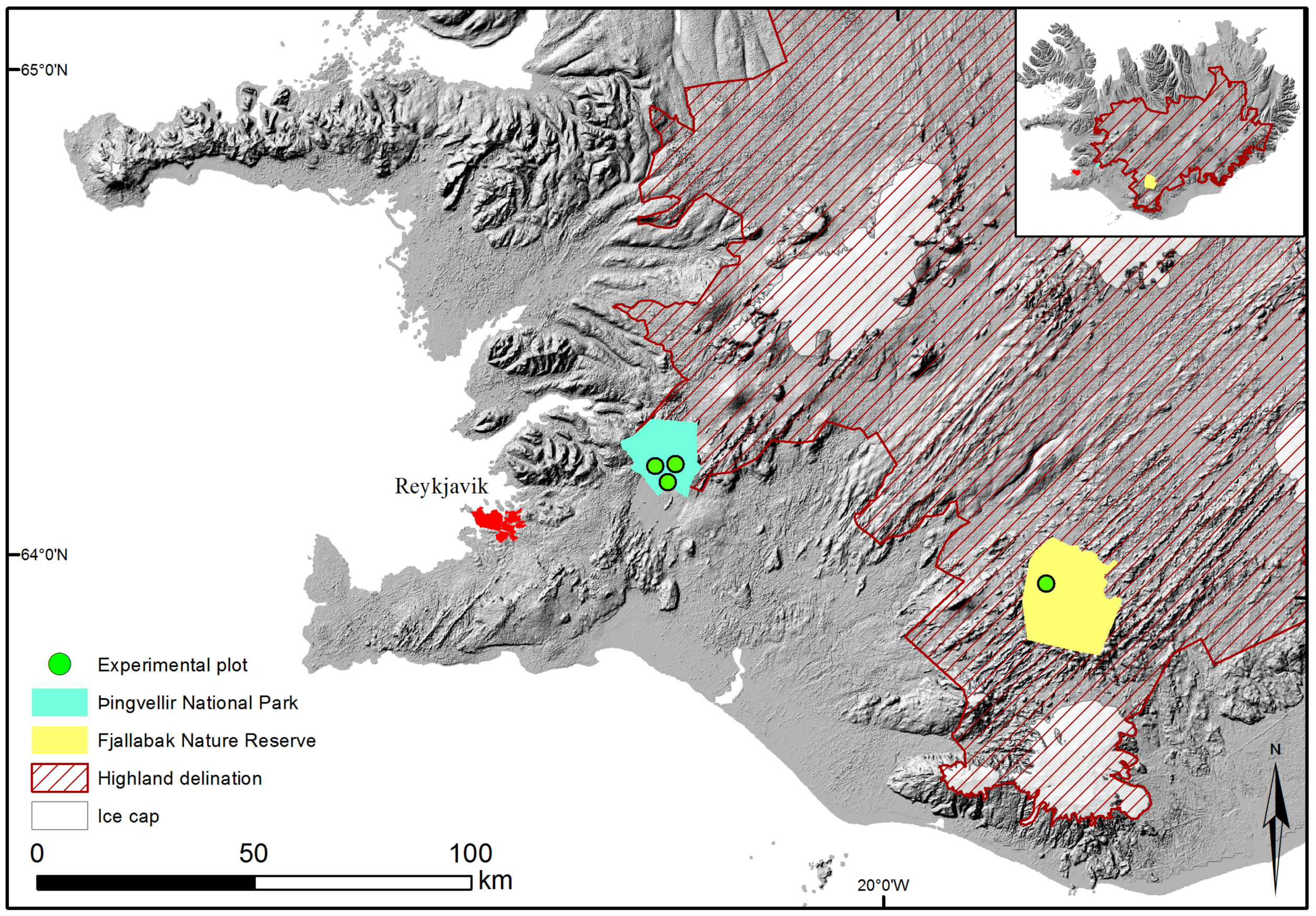
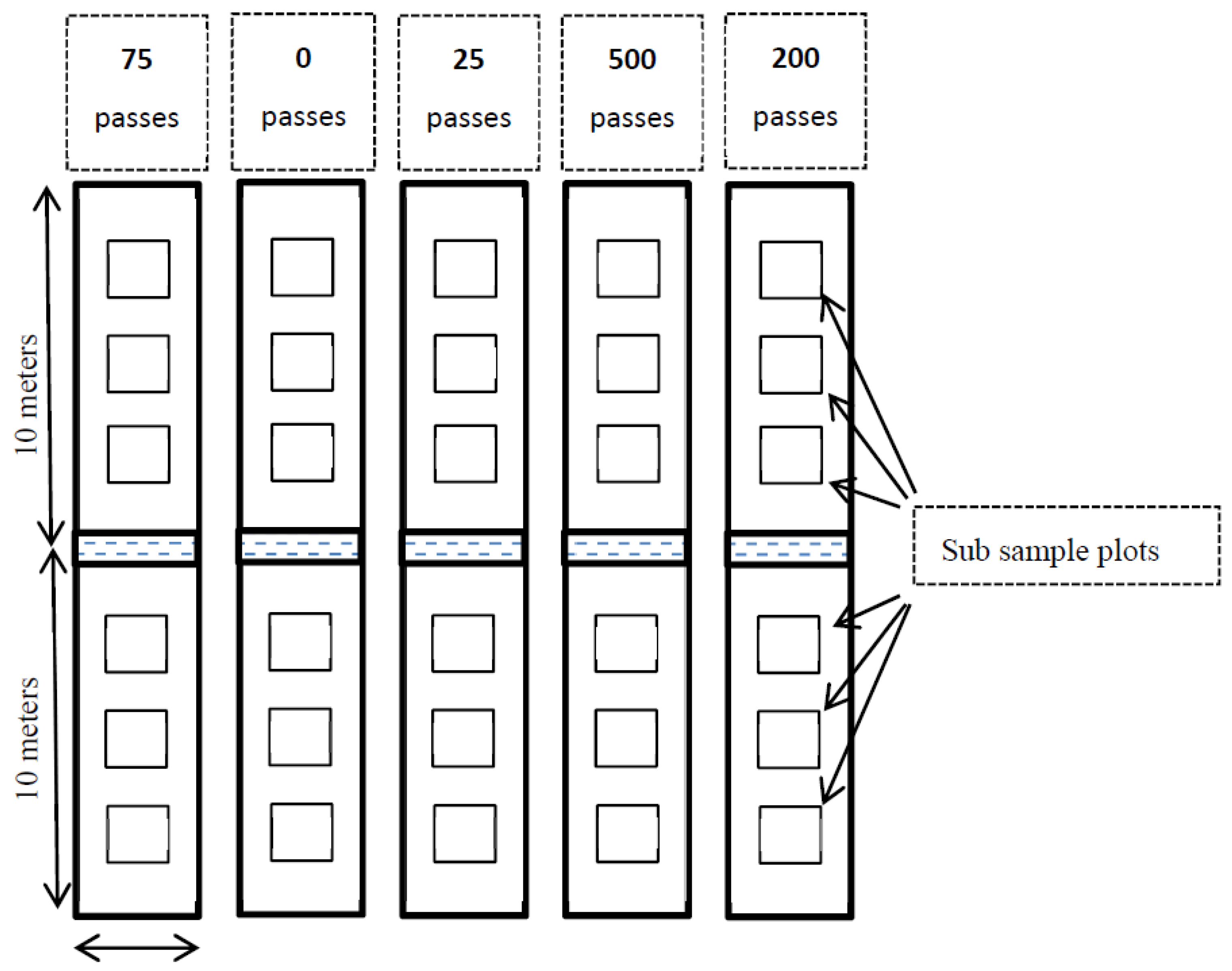

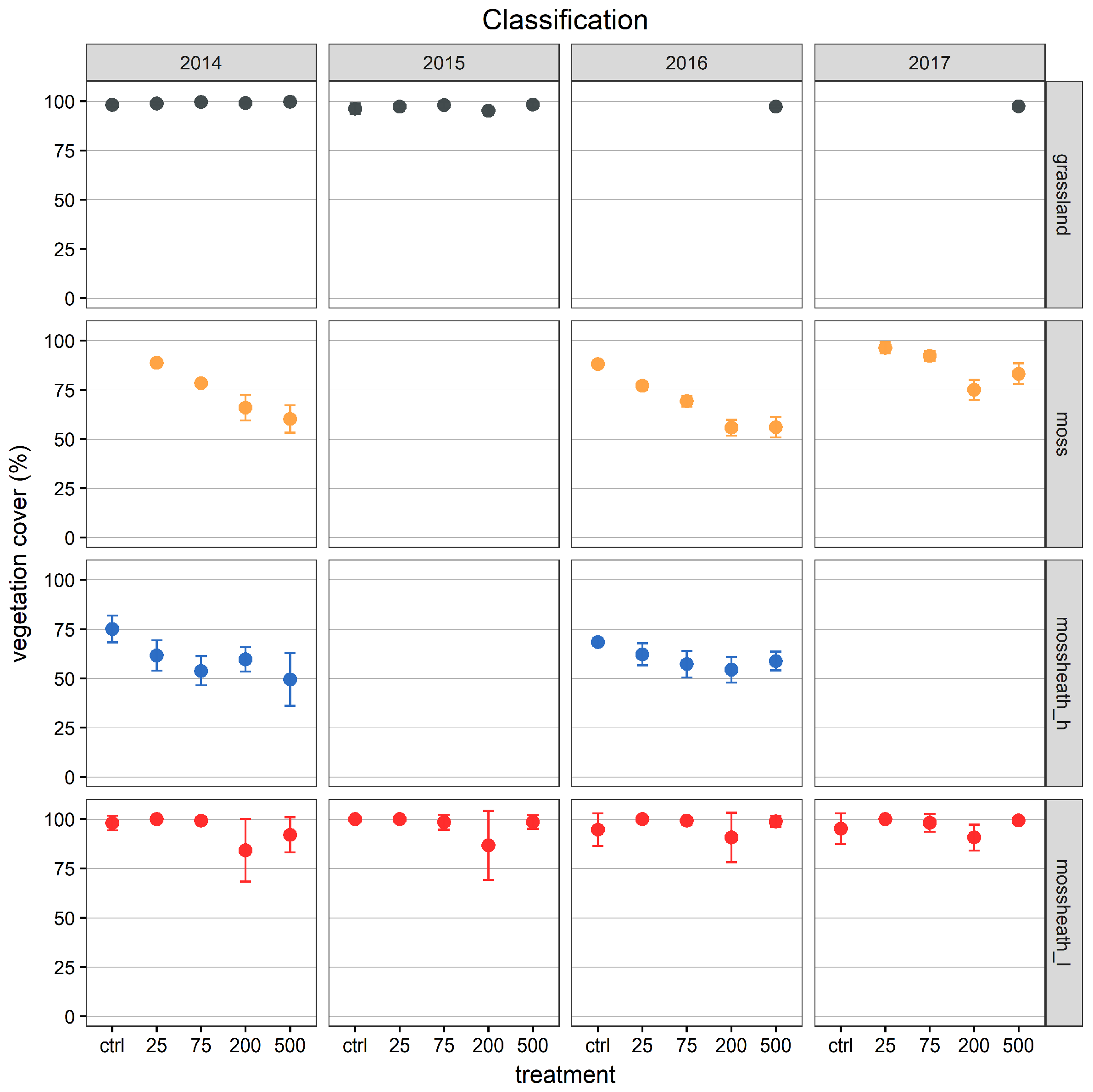
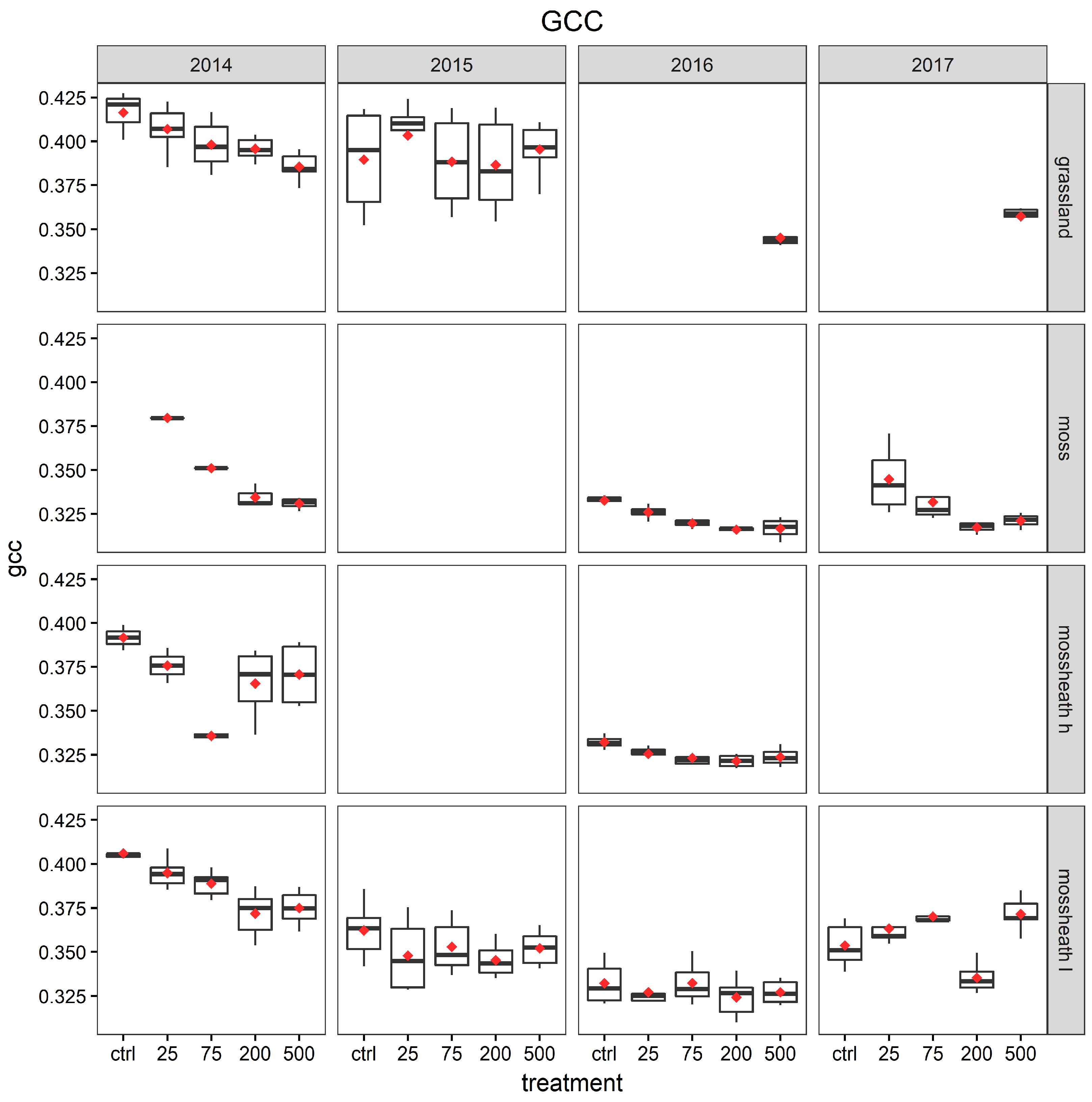
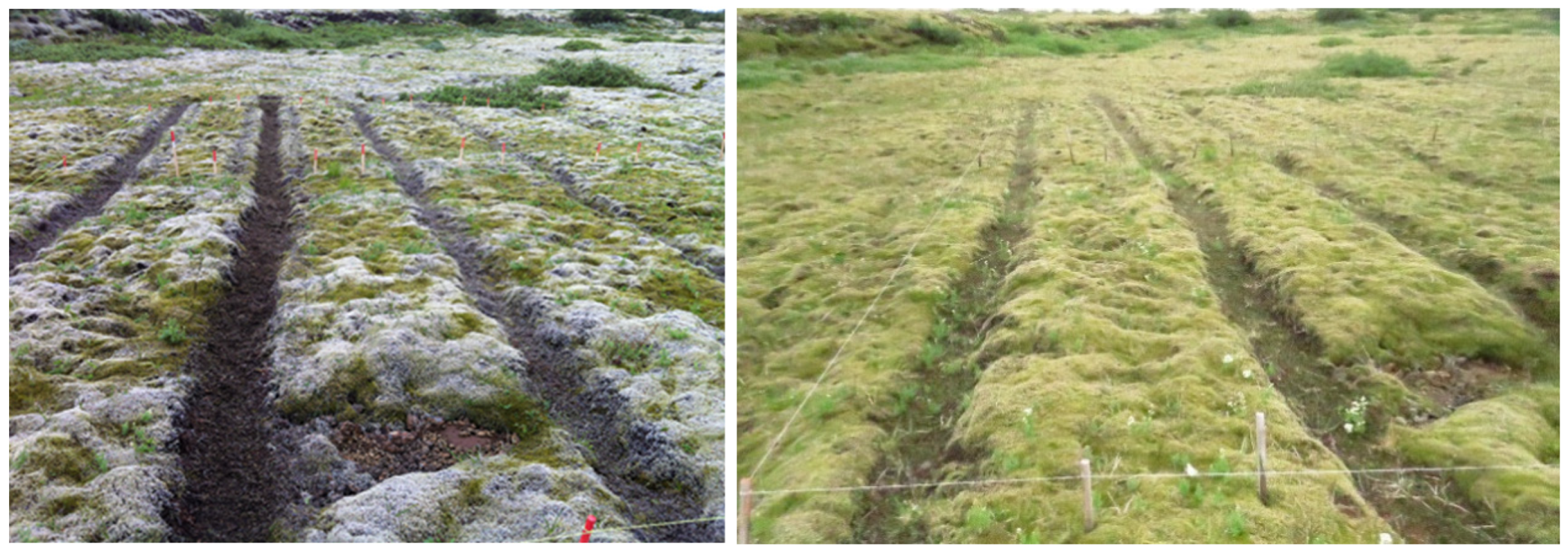
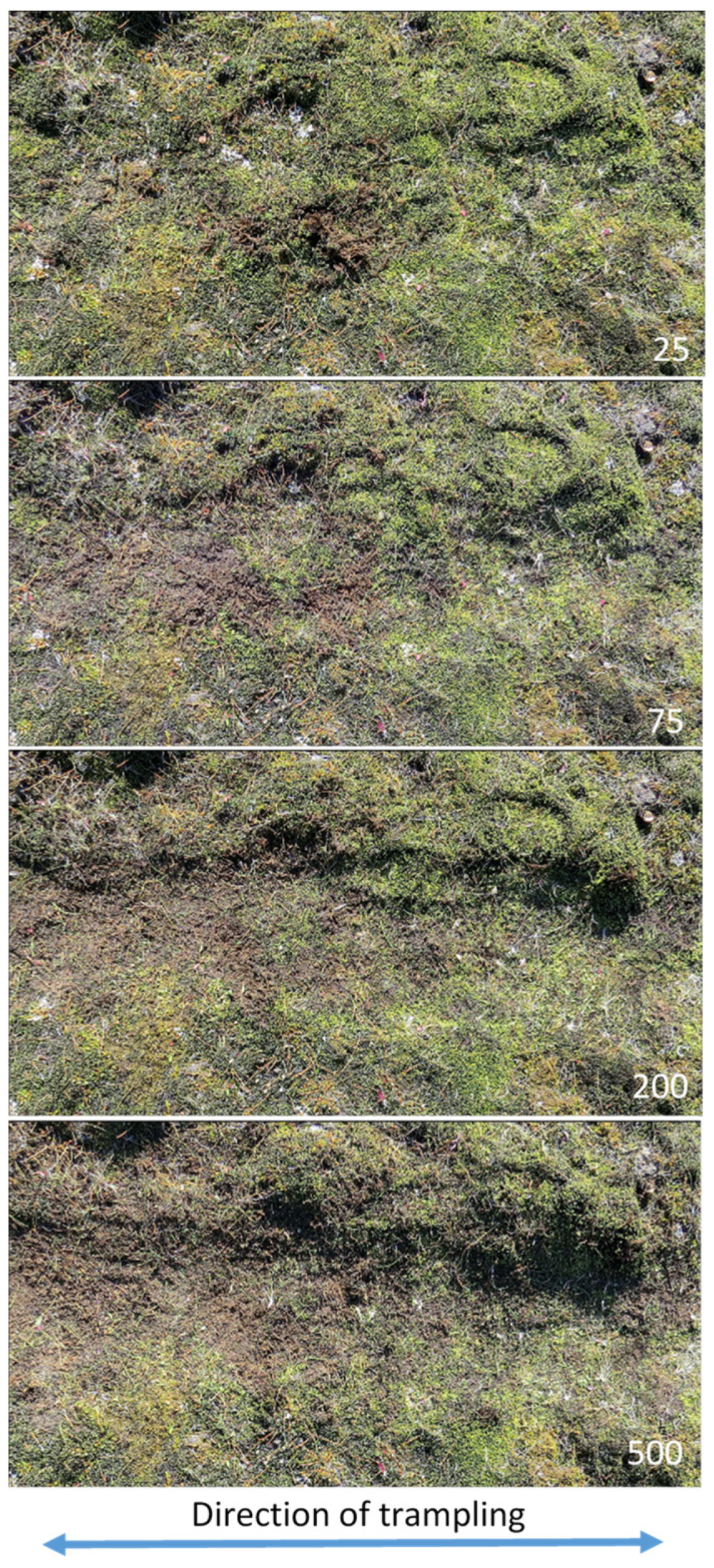
| Lowland (ÞNP) | Highland (FNR) | |||||||||||||||||||
|---|---|---|---|---|---|---|---|---|---|---|---|---|---|---|---|---|---|---|---|---|
| Moss | Moss-heath | Grassland | Moss-heath | |||||||||||||||||
| Treatment class | Treatment class | Treatment class | Treatment class | |||||||||||||||||
| Year | Control | 25 | 75 | 200 | 500 | Control | 25 | 75 | 200 | 500 | Control | 25 | 75 | 200 | 500 | Control | 25 | 75 | 200 | 500 |
| 2014 | / | 4 | 4 | 4 | 4 | 6 | 6 | 6 | 6 | 6 | 6 | 6 | 6 | 6 | 6 | 2 | 2 | 2 | 4 | 4 |
| 2015 | / | / | / | / | / | 6 | 6 | 6 | 6 | 6 | 6 | 6 | 6 | 6 | 6 | / | / | / | / | / |
| 2016 | 4 | 4 | 4 | 4 | 4 | 6 | 6 | 6 | 6 | 6 | / | / | / | / | 6 | 6 | 6 | 6 | 6 | 6 |
| 2017 | / | 4 | 4 | 4 | 4 | 6 | 6 | 6 | 6 | 6 | / | / | / | / | 6 | / | / | / | / | / |
| ANOVA | ||||||||||
|---|---|---|---|---|---|---|---|---|---|---|
| Vegetation Cover (MLC) | GCC | |||||||||
| 2014 | 2015 | 2016 | 2017 | 2014 | 2015 | 2016 | 2017 | |||
| Lowland | Grassland | Con - 25 | (0.8) | (0.75) | - | - | (0.97) | (0.8) | - | - |
| Con - 75 | * (8.79) | (2.03) | - | - | (3.47) | (0.01) | - | - | ||
| Con - 200 | (2.2) | (0.65) | - | - | * (10.09) | (0.03) | - | - | ||
| Con - 500 | * (9.62) | (2.68) | - | - | ** (18.8) | (0.19) | - | - | ||
| Moss | Con - 25 | - | - | *** (67.14) | - | - | - | (5.92) | - | |
| Con - 75 | - | - | *** (137.9) | - | - | - | *** (35.56) | - | ||
| Con - 200 | - | - | *** (212.5) | - | - | - | *** (67.0) | - | ||
| Con - 500 | - | - | *** (131.9) | - | - | - | ** (19.53) | - | ||
| 25 - 75 | - | - | ** (22.51) | (4.82) | - | - | * (6.79) | (1.19) | ||
| 25 - 200 | (9.06) | - | *** (89.53) | *** (52.28) | * (33.41) | - | ** (18.8) | * (7.2) | ||
| 25 - 500 | * (13.48) | - | *** (55.6) | ** (19.03) | *** (168.6) | - | * (6.08) | (5.20) | ||
| Moss-heath L | Con - 25 | (1.66) | (11.22) | (2.5) | (2.32) | * (8.94) | (1.81) | (0.53) | (2.14) | |
| Con - 75 | (0.54) | (1.0) | (1.7) | (0.66) | *** (27.12) | (1.11) | (0.0) | * (8.39) | ||
| Con - 200 | (4.3) | (3.44) | (0.43) | (1.18) | *** (38.26) | * (5.03) | (1.45) | * (8.9) | ||
| Con - 500 | (2.26) | (1.0) | (1.35) | (1.72) | *** (53.53) | (1.79) | (0.85) | * (7.78) | ||
| Highland | Moss-heath H | Con - 25 | (3.41) | - | * (6.68) | - | (1.65) | - | * (7.87) | - |
| Con - 75 | (8.97) | - | ** (15.4) | - | * (56.79) | - | ** (13.02) | - | ||
| Con - 200 | * (7.85) | - | *** (25.75) | - | (2.39) | - | *** (30.01) | - | ||
| Con - 500 | (6.06) | - | ** (20.8) | - | (1.91) | - | ** (12.43) | - | ||
| MLC | Plant community | RI 2014 | RI Ratio (2014) | RI 2016 | RI Ratio (2016) |
| Grassland | 102% | Tclass500/TclassControl | 101% | Tclass500/TclassControl (2015) | |
| Moss | 68% | Tclass500/Tclass25 | 78% | Tclass500/Tclass25 | |
| Moss | 68% | Tclass500/TclassControl (2016) | 63% | Tclass500/TclassControl (2016) | |
| Moss-heath_L | 94% | Tclass500/TclassControl | 101% | Tclass500/TclassControl | |
| Moss-heath_H | 66% | Tclass500/TclassControl | 86% | Tclass500/TclassControl | |
| GCC | Grassland | 93% | Tclass500/TclassControl | 89% | Tclass500/TclassControl (2015) |
| Moss | 87% | Tclass500/Tclass25 | 97% | Tclass500/Tclass25 | |
| Moss | 99% | Tclass500/TclassControl (2016) | 95% | Tclass500/TclassControl (2016) | |
| Moss-heath_L | 92% | Tclass500/TclassControl | 98% | Tclass500/TclassControl | |
| Moss-heath_H | 95% | Tclass500/TclassControl | 97% | Tclass500/TclassControl |
© 2019 by the authors. Licensee MDPI, Basel, Switzerland. This article is an open access article distributed under the terms and conditions of the Creative Commons Attribution (CC BY) license (http://creativecommons.org/licenses/by/4.0/).
Share and Cite
Runnström, M.C.; Ólafsdóttir, R.; Blanke, J.; Berlin, B. Image Analysis to Monitor Experimental Trampling and Vegetation Recovery in Icelandic Plant Communities. Environments 2019, 6, 99. https://doi.org/10.3390/environments6090099
Runnström MC, Ólafsdóttir R, Blanke J, Berlin B. Image Analysis to Monitor Experimental Trampling and Vegetation Recovery in Icelandic Plant Communities. Environments. 2019; 6(9):99. https://doi.org/10.3390/environments6090099
Chicago/Turabian StyleRunnström, Micael C., Rannveig Ólafsdóttir, Jan Blanke, and Bastian Berlin. 2019. "Image Analysis to Monitor Experimental Trampling and Vegetation Recovery in Icelandic Plant Communities" Environments 6, no. 9: 99. https://doi.org/10.3390/environments6090099
APA StyleRunnström, M. C., Ólafsdóttir, R., Blanke, J., & Berlin, B. (2019). Image Analysis to Monitor Experimental Trampling and Vegetation Recovery in Icelandic Plant Communities. Environments, 6(9), 99. https://doi.org/10.3390/environments6090099





